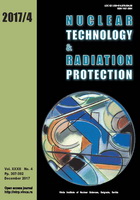
EXTRA RADIATION DOSE OF LUNGS IN MALE EXAMINEES DURING CARDIAC COMPUTED TOMOGRAPHY

Vol.
XXXII, No. 4, Pp. 307-392
December 2017
UDC 621.039+614.876:504.06
ISSN 1451-3994
Pages: 350-357
Authors: Sung-Yi Tsai, Hsien-Chun Tseng, Zhipeng Ruan, Zumei Xu, Yonggui Liao, Sheng-Pin Changlai, and Chien-Yi ChenAbstract
The use of multi-detector row computed tomography in cardiac examinations is increasing globally. Several hospitals are yet to establish a practical method for evaluating the extra scattering dose in the lungs (Dlung) of male examinees with different body-weights undergoing cardiac computed tomography. To measure the dose in each slice of a lung (Dlung,i), thermoluminescent dosimeters are inserted into Rando and tissue-equivalent phantoms made of polymethylmethacrylate and derived from ICRU 48 with masses from 10 to 90 kg. Dlung was evaluated by weighing the scanned volume of each slice. A practical method for determining
Dlung involves 64-slice computed tomography scans using a Philips Brilliance computed tomography at 120 kV and 200 mAs, with a thickness of 1.0 mm.Dlung,i increased with distance from the scanning region. This experiment yieldedDlung values from 12.1 ± 2.1 mSv (90 kg) to 23.0 ± 3.8 mSv (10 kg). Finally, a simple equation can be used to derive the relationship betweenDlung and the body-weights of a male examinee. Experimental results are compared with others in the literature.
Key words: cardiac computed tomography, lung dose, thermoluminescent dosimeter,
tissue-equivalent phantom
FULL PAPER IN PDF FORMAT (1.01 MB)